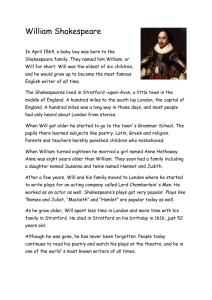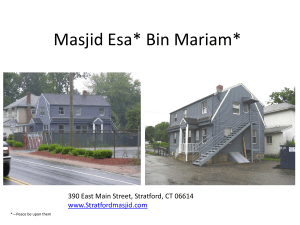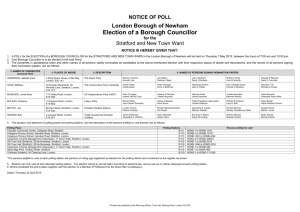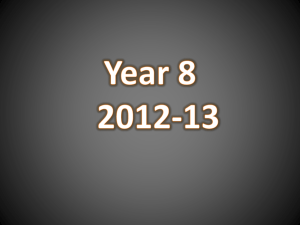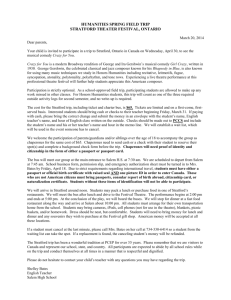Computer Fundamental
advertisement
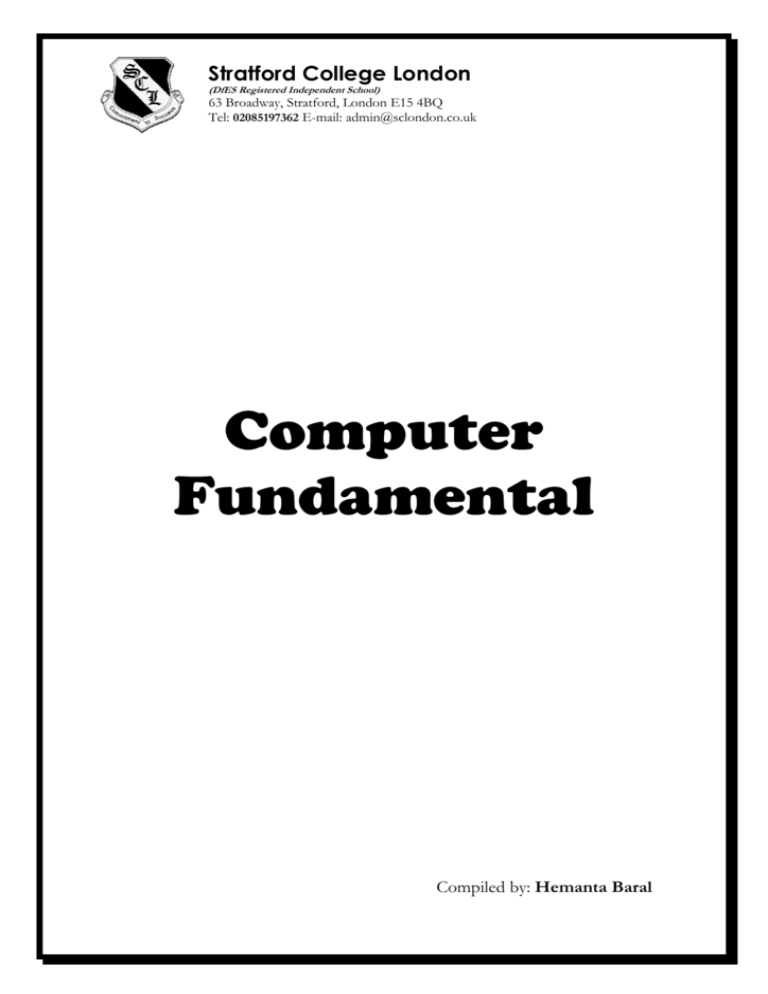
Stratford College London (DfES Registered Independent School) 63 Broadway, Stratford, London E15 4BQ Tel: 02085197362 E-mail: admin@sclondon.co.uk Computer Fundamental Compiled by: Hemanta Baral Stratford College London (DfES Registered Independent School) 63 Broadway, Stratford, London E15 4BQ Tel: 02085197362 E-mail: admin@sclondon.co.uk Computer Fundamentals What is Computer? Computer is an advanced electronic device that takes raw data as input from the user and processes these data under the control of set of instructions (called program) and gives the result (output) and saves output for the future use. It can process both numerical and non-numerical (arithmetic and logical) calculations. A computer has four functions: a. accepts data b. processes data c. produces output d. stores results Input Processing Output Storage Input (Data): Input is the raw information entered into a computer from the input devices. It is the collection of letters, numbers, images etc. Process: Process is the operation of data as per given instruction. It is totally internal process of the computer system. Output: Output is the processed data given by computer after data processing. Output is also called as Result. We can save these results in the storage devices for the future use. Computer System All of the components of a computer system can be summarized with the simple equations. COMPUTER SYSTEM = HARDWARE + SOFTWARE+ USER • Hardware = Internal Devices + Peripheral Devices All physical parts of the computer (or everything that we can touch) are known as Hardware. • Software = Programs Software gives "intelligence" to the computer. • USER = Person, who operates computer. Computer Fundamentals -2- Stratford College London (DfES Registered Independent School) 63 Broadway, Stratford, London E15 4BQ Tel: 02085197362 E-mail: admin@sclondon.co.uk Major parts of the Computer Input Devices 1. Mouse 3. Scanner 5. Web Camera 7. Track Ball 2. Keyboard 4. Digital Camera 6. Joysticks 8. Touch Pad/ Screen 9. Light Pen 10. Bar Code Reader 11. Microphone 12. Graphics Tablets Computer Fundamentals -3- Stratford College London (DfES Registered Independent School) 63 Broadway, Stratford, London E15 4BQ Tel: 02085197362 E-mail: admin@sclondon.co.uk 13. Magnetic Ink Character Reader (Used in Bank) 14. Optical Mark Reader (Used for AnswerSheet Marking Purpose) 15. Magnetic Card Reader (Used in Shops, Colleges, Stations etc) 16. Biometric Devices 17. Bluetooth Computer Fundamentals -4- Stratford College London (DfES Registered Independent School) 63 Broadway, Stratford, London E15 4BQ Tel: 02085197362 E-mail: admin@sclondon.co.uk Processor CENTRAL PROCESSING UNIT (CPU) The main unit inside the computer is the CPU. This unit is responsible for all events inside the computer. It controls all internal and external devices, performs arithmetic and logic operations. The CPU (Central Processing Unit) is the device that interprets and executes instructions. Output Devices 1. Monitor 2. Printer (Dot Matrix) 3. Projector InkJet 4. Plotter Laser 5. Speaker Computer Fundamentals -5- Stratford College London (DfES Registered Independent School) 63 Broadway, Stratford, London E15 4BQ Tel: 02085197362 E-mail: admin@sclondon.co.uk Storage Devices 1. Primary memory (main memory) A. RAM (Random Access Memory/Read-Write Memory) B. ROM (Read-only-memory) 2. Secondary memory (storage devices) A. Hard Disk (Local Disk) B. Optical Disks: CD-R, CD-RW, DVD-R, DVD-RW C. Pen Drive D. Zip Drive E. Floppy Disks F. Memory Cards G. External Hard Disk A. Hard Disk Computer Fundamentals -6- Stratford College London (DfES Registered Independent School) 63 Broadway, Stratford, London E15 4BQ Tel: 02085197362 E-mail: admin@sclondon.co.uk B. Optical disk C. Pen Drive D. Zip Disk (super disk) E. Floppy Disk F. Memory Cards G. External Hard Disk Peripheral Devices 1. The Modem/ Internet Adapter 2. Switches/H ub 3. Router 4. TV Tuner Card Computer Fundamentals -7- Stratford College London (DfES Registered Independent School) 63 Broadway, Stratford, London E15 4BQ Tel: 02085197362 E-mail: admin@sclondon.co.uk Internal Components 1. The Mother Board 2. Expansion Slots 3. CMOS Battery 4. Cooling Fan 5. Network Card 6. Graphics Card 7. Power Supply Unit (SMPS) 8. Memory Slots Software Software, simply are the computer programs. The instructions given to the computer in the form of a program is called Software. Software is the set of programs, which are used for different purposes. All the programs used in computer to perform specific task is called Software. Types of software 1. System software: a) Operating System Software DOS, Windows XP, Windows Vista, Unix/Linux, MAC/OS X etc. b) Utility Software Windows Explorer (File/Folder Management), Windows Media Player, AntiVirus Utilities, Disk Defragmentation, Disk Clean, BackUp, WinZip, WinRAR etc… Computer Fundamentals -8- Stratford College London (DfES Registered Independent School) 63 Broadway, Stratford, London E15 4BQ Tel: 02085197362 E-mail: admin@sclondon.co.uk 2. Application software: a) Package Software Ms. Office 2003, Ms. Office 2007, Macromedia (Dreamweaver, Flash, Freehand), Adobe (PageMaker, PhotoShop) b) Tailored or Custom Software SAGE (Accounting), Galileo/Worldspan (Travel) etc. 3. Computer Languages & Scripting: a) Low Level Language i) Machine Level Language ii) Assembly Language Machine language: These language instructions are directly executed by CPU Assembly language: The endeavor of giving machine language instructions a name structure that means bit strings of instructions of machine language are given name here High Level Language: The user friendly language ...more natural language than assembly language. Assembler is needed to convert assembly language into machine language Complier is needed to convert high level to machine language b) High Level Language COBOL (COmmon Business Oriented Language), FORTRAN (FORmula TRANslation), BASIC (Beginner's All-purpose Symbolic Instruction Code), C, C++ etc. are the examples of High Level Language. Types of Computer On the basis of working principle a) Analog Computer An analog computer (spelt analogue in British English) is a form of computer that uses continuous physical phenomena such as electrical, mechanical, or hydraulic quantities to model the problem being solved. Computer Fundamentals -9- Stratford College London (DfES Registered Independent School) 63 Broadway, Stratford, London E15 4BQ Tel: 02085197362 E-mail: admin@sclondon.co.uk 1. Thermometer 2. Speedometer 3. Petrol Pump Indicator 4. Multimeter b) Digital Computer A computer that performs calculations and logical operations with quantities represented as digits, usually in the binary number system. c) Hybrid Computer (Analog + Digital) A combination of computers those are capable of inputting and outputting in both digital and analog signals. A hybrid computer system setup offers a cost effective method of performing complex simulations. Computer Fundamentals - 10 - Stratford College London (DfES Registered Independent School) 63 Broadway, Stratford, London E15 4BQ Tel: 02085197362 E-mail: admin@sclondon.co.uk On the basis of Size a) Super Computer The fastest type of computer. Supercomputers are very expensive and are employed for specialized applications that require immense amounts of mathematical calculations. For example, weather forecasting requires a supercomputer. Other uses of supercomputers include animated graphics, fluid dynamic calculations, nuclear energy research, and petroleum exploration. The chief difference between a supercomputer and a mainframe is that a supercomputer channels all its power into executing a few programs as fast as possible, whereas a mainframe uses its power to execute many programs concurrently. b) Mainframe Computer A very large and expensive computer capable of supporting hundreds, or even thousands, of users simultaneously. In the hierarchy that starts with a simple microprocessor (in watches, for example) at the bottom and moves to supercomputers at the top, mainframes are just below supercomputers. In some ways, mainframes are more powerful than supercomputers because they support more simultaneous programs. But supercomputers can execute a single program faster than a mainframe. c) Mini Computer A midsized computer. In size and power, minicomputers lie between workstations and mainframes. In the past decade, the distinction between large minicomputers and small mainframes has blurred, however, as has the distinction between small minicomputers and workstations. But in general, a minicomputer is a multiprocessing system capable of supporting from 4 to about 200 users simultaneously. Computer Fundamentals - 11 - Stratford College London (DfES Registered Independent School) 63 Broadway, Stratford, London E15 4BQ Tel: 02085197362 E-mail: admin@sclondon.co.uk d) Micro Computer i. Desktop Computer: a personal or micro-mini computer sufficient to fit on a desk. ii. Laptop Computer: a portable computer complete with an integrated screen and keyboard. It is generally smaller in size than a desktop computer and larger than a notebook computer. iii. Palmtop Computer/Digital Diary /Notebook /PDAs: a hand-sized computer. Palmtops have no keyboard but the screen serves both as an input and output device. Computer Fundamentals - 12 - Stratford College London (DfES Registered Independent School) 63 Broadway, Stratford, London E15 4BQ Tel: 02085197362 E-mail: admin@sclondon.co.uk e) Workstations A terminal or desktop computer in a network. In this context, workstation is just a generic term for a user's machine (client machine) in contrast to a "server" or "mainframe." On the basis of Brand a) IBM/IBM Compatible Computers c) Apple/Macintosh Booting The process of loading the system files of the operating system from the disk into the computer memory to complete the circuitry requirement of the computer system is called booting. The system files of MS. DOS are: Types of Booting: There are two types of booting: • Cold Booting: If the computer is in off state and we boot the computer by pressing the power switch ‘ON’ from the CPU box then it is called as cold booting. Computer Fundamentals - 13 - Stratford College London (DfES Registered Independent School) 63 Broadway, Stratford, London E15 4BQ Tel: 02085197362 E-mail: admin@sclondon.co.uk • Warm Booting: If the computer is already ‘ON’ and we restart it by pressing the ‘RESET’ button from the CPU box or CTRL, ALT and DEL key simultaneously from the keyboard then it is called warm booting. How to start the Computer in Ms. Windows mode? There is nothing special you need to start this system. Just, 1. Switch ON the Power Supply. 2. Switch ON the CPU and, 3. Switch ON the Screen (Monitor). How to Shutdown (Turn Off) the Computer? Before shutting down the Computer, close all opened windows at first. Then, 1. Click on Start button. 2. Click on Shutdown (Turn Off Computer). Then, Computer asks you: What do you want the Computer to do? • Standby • Shutdown (Turn Off) • Restart • Restart in MS-DOS mode. Note: The options will be different from one OS to another. 3. Choose 2nd option (i.e. Shutdown/Turn Off). 4. Click on OK. Then, wait until the message “It’s now safe to turn off your Computer”. 5. Then, Switch Off the screen. 6. Switch Off the CPU. 7. At last, Switch Off the power supply. Computer Fundamentals - 14 - Stratford College London (DfES Registered Independent School) 63 Broadway, Stratford, London E15 4BQ Tel: 02085197362 E-mail: admin@sclondon.co.uk Basic Computer Literacy Quiz One 1. Which one is not an output device? o Printer o Monitor o Keyboard o Modem 2. Which one works as an output and input device? o Modem o Scanner o Mouse o Monitor 3. All computers must have: o Word processing software o An operating system o A printer attached o A virus checking program 4. The brain of the computer is called: o Random Access Memory or RAM o Central Processing Unit or CPU o Read Only Memory or ROM o BIOS 5. An operating system is: o Integrated software o CD-ROM software o Application software o System software 6. Software is: o A computer program o A set of instructions o All of the above o Only in operating systems 7. One MB is equal to: o The amount of RAM in every computer o 1 billion bytes o 1024KB o 1 thousand bytes Computer Fundamentals - 15 - Stratford College London (DfES Registered Independent School) 63 Broadway, Stratford, London E15 4BQ Tel: 02085197362 E-mail: admin@sclondon.co.uk 8. The resolution of a printer is measured in: o Megabits o Hz o Dots per inch (DPI) o Inches (diagonal) 9. Windows and Macintosh computers: o Are both manufactured by Motorola o Both use Intel microprocessors o Use the same operating system o Are not compatible 10. A computer port is used to: o Communicate with other computer peripherals o Download files from the web o Communicate with all hard drives o Connect computers together Quiz Two 11. Which computer is the fastest? o PII 600MHz o PIII 600MHz o Pentium 600MHz o 486 Turbo 12. Which hard disk will be able to store more information? o 24MB o 2400KB o 24Gig o 240MB 13. In order for your computer to play music you need: o A network card and speakers o A sound card and speakers o Nothing more than the internal speaker o A CD-ROM drive 14. In order to access the World Wide Web you need: o An Internet connection, an Internet Service Provider and browser software o Only Internet Explorer or Netscape Navigator o A modem and a browser o Nothing. All computers can access the Internet Computer Fundamentals - 16 - Stratford College London (DfES Registered Independent School) 63 Broadway, Stratford, London E15 4BQ Tel: 02085197362 E-mail: admin@sclondon.co.uk 15. If you have two different printers attached to your computer: o It is not possible to have two printers attached to a single computer o You need to install a single printer driver o You need to use application software that can recognize both printers o You need to install two different printer drivers in order to be able to print to either printer 16. Which file extensions indicate only graphics files? o BMP and DOC o JPEG and TXT o TXT and STK o BMP and GIF 17. Which Windows program do you use to manage folders and files? o Windows Explorer o Windows Accessories o Microsoft Office o Windows Control Panel 18. What is a URL: o An email address o The title of a web site o The address of a page on the World Wide Web o A communication method between computers and printers 19. Which media holds more information? o Floppy diskette o DVD o CD-ROM o Zip drive 20. Which one is an email address: o http://vianet.com/index.htm o D:\\Email\Standard o joesmart@billme.com o Chaminade.org/teachers/mailaddresses Quiz Three 21. CPU means (1 point) o Central Processing Unit o Controlled Program Utilization o Computer Programming Unit o Computerized Processing Unit 22. Computers use a special code for representing letters and numbers, known as the (1 point) Computer Fundamentals - 17 - Stratford College London (DfES Registered Independent School) 63 Broadway, Stratford, London E15 4BQ Tel: 02085197362 E-mail: admin@sclondon.co.uk o o o o processing code binary code CRX code integrated code 23. The main circuit board in the computer that connects the parts of the computer is the (1 point) o hard drive o motherboard o fatherboard o main board 24. The part of the computer that processes the information is the (1 point) o floppy disk o CD-ROM drive o monitor o microprocessor 25. Which of these is not an example of an input device? (1 point) o keyboard o mouse o hard drive o scanner 26. Processing speed in computers is measured in (1 point) o millivolts (mV) o hertz (Hz) o megahertz (MHz) o rpm's 27. External devices such as printers and scanners plug into ___ in the back of the computer. (1 point) o RX-5's o expansion slots o outlets o ports 28. Windows is (1 point) o a kind of operating system. o a graphics display device. o a monitor display system. o a video game. Computer Fundamentals - 18 - Stratford College London (DfES Registered Independent School) 63 Broadway, Stratford, London E15 4BQ Tel: 02085197362 E-mail: admin@sclondon.co.uk 29. To "boot a computer" means to (1 point) o add extra drives. o turn on the sound. o turn it on. o throw it out - it's outdated. 30. The hard drive in the computer is usually (1 point) o Drive A. o Drive B. o Drive C. o Drive H. 31. A "byte" is (1 point) o found in the upper right corner of a window screen. o a group of 8 bits of code. o the capacity of a sound card. o the part that moves on a disk drive. 32. When you click SAVE on the monitor, and there is no floppy disk in a drive, the document or application you're using is stored (1 point) o on the RAM chips. o on the CD-ROM drive. o in ROM memory. o on the hard drive. 33. Pictures on the display screen (monitor) are made up of (1 point) o pixels. o layers of color. o bits. o video "packets" 34. Temporary memory is called (1 point) o RAM o CAD o DOS o ROM 35. Which of these is not one of the three main functions of a microprocessor? (1 point) o fetch o store o decode o execute 36. Which of these is not an example of computer hardware? (1 point) o video card o mouse o CD-ROM drive o Windows Computer Fundamentals - 19 - Stratford College London (DfES Registered Independent School) 63 Broadway, Stratford, London E15 4BQ Tel: 02085197362 E-mail: admin@sclondon.co.uk 37. To "debug" the system means to (1 point) o clean it. o find and correct errors. o decode it. o set up icons. 38. A megabyte is (1 point) o 1,000 bytes o 1 byte o 1 million bytes o 1 trillion bytes 39. Formatting a disk means (1 point) o installing an operating system on it. o setting up sections on the disk to store the files in. o cleaning the disk from any dust contaminates. o programming the disk so data on it can't be erased. 40. A system that connects individual computers together is a(n) (1 point) o operating system. o network. o tape drive system. o partnered path. 41. When you use a PC, you are using a (1 point) o programmable console. o powered calculating machine. o personal computer. o processing contraption. 42. VDU stands for: o Video Display Unit o Visible Display Unit o Visual Display Unit o Video Diode Unit Computer Fundamentals - 20 -
